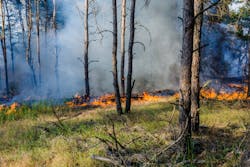PG&E Searches for Innovative Solutions to Prevent Wildfire Ignitions
PG&E is taking a new approach to technology development and deployment and is conducting an open innovation challenge with ADL Ventures, an energy and sustainability consultancy, looking to the entrepreneur and startup community for novel approaches to prevent electric equipment from igniting wildfires.
In recent years, PG&E has taken many safety actions and implemented a risk-based, comprehensive approach to further reduce fire risks including accelerated safety inspections of the company’s electric system, enhanced vegetation management, and new operational protocols with short-, medium- and long-term plans to make its system safer, according to a PG&E Currents story by Paul Doherty.
Additionally, the company is testing and developing technologies to proactively detect (and resolve) grid-related issues prior to catastrophic failure.
Now, the company is looking directly to the entrepreneur and start-up community for additional help.
Sponsored by the U.S. Department of Energy, ADL Ventures’ ProblemSpace.io platform offers PG&E a new pathway to engage technology entrepreneurs and entrepreneurial-minded academics with new and creative solutions to reduce utility-caused wildfire ignition risk.
“Instead of starting out by looking at what solutions to a problem are currently available and trying to apply them, the ProblemSpace process takes a different approach by starting with an existing problem, engaging the market, and then crafting a solution that’s designed to address the specific need,” said Chris Richardson, partner, ADL Ventures. “Given that viable, commercially available solutions to these wildfire ignition prevention challenges do not yet exist, we actively encourage technologies that are at an early stage, that way PG&E can have a more active hand in piloting and deploying them with the ultimate goal of addressing the problem head on with new commercially viable solutions, products or processes.”
PG&E is seeking input across four specific areas:
Innovative materials – As a key part of electric system hardening focuses on updating overhead power lines and equipment, PG&E has to consider over 30,000 line-miles of transmission and distribution powerlines and equipment in High Fire Threat Districts in its service area. Industry-wide adoption of lighter, stronger, and/or more heat-resistant infrastructure has been limited by cost, availability and longevity.
- In this challenge, PG&E seeks any technical solution or process innovation that makes grid infrastructure stronger, less likely to fault when contacted and more fire-resistant. These approaches could include innovations in pole infrastructure, particularly related to composite pole reliability, scalability, fabrication, and inputs. Also of interest are innovations in wiring and supporting equipment, especially lighter, stronger, and/or more heat resistant materials.
Reducing labor required for vegetation management – As vegetation contact with electric equipment is a leading source of wildfire ignitions, the California Public Utilities Commission (CPUC) requires specific clearances around power lines. By making current advanced practices of onsite vegetation management more efficient, utilities could improve risk reduction on the many thousands of conductor line-miles in HFTDs.
- In this challenge, PG&E searched for any technical solution or equipment innovation that reduces vegetation management labor costs. Novel, cost-effective approaches to surveying—limiting the pre-work design, planning and vegetation removal assessments—is one approach. Another area of interest is optimizing labor through automation, such as robotic or otherwise efficient and nimble vegetation pruning and removal, particularly in sloped, mountainous, and/or vegetation-heavy areas.
“Monitor & mitigate” technologies for real-time detection of faults and prevention of arcing, sparking and other ignition events along transmission and distribution infrastructure: Current state-of-the-art technologies to detect faults in real-time and prevent ignition from these faults can reduce risk, but remain expensive, slow to install, and require tuning and maintenance to be effective. Additionally, sensor technologies to detect precursor signatures to equipment failures, while promising, are nascent.
- In this challenge, PG&E seeks any technical solution or process innovation that improves upon current state-of-the-art monitoring and/or mitigation capabilities either by increasing functionality, efficiency or reducing cost.
Alternatives to current undergrounding methods, including level-grounding: Undergrounding distribution power lines eliminates almost all risk of infrastructure-caused wildfire ignitions; however, the process can be costly, slow, and bounded by regulation, objections, physical limitations and irregular terrain. While these constraints have limited the extent of undergrounding, efforts to bring electric lines at or below grade could be accelerated if the process could be faster and less costly.
- In this challenge, PG&E looked for any technical solution or process innovation that provides cost-effective alternatives to overhead power lines. One possible approach is through level-grounding, as opposed to under-grounding, whereby circuits are not buried as deeply underground but still protected. Surveying technologies such as radar-based drone/computer vision mapping and real-time trenching guidance could reduce complications of the undergrounding process. Another area of opportunity is reducing the time and labor required for trench digging, including robotic boring and excavation, reducing the footprint required for burying lines (necessary for installation next to narrow mountainous roads and in scenic areas), and/or new techniques for installing, maintaining and accessing wires underneath roads.
The winner of the challenge will receive consideration for a demonstration or development contract through one of several PG&E innovation programs as well as potential introductions by PG&E to other California utility innovation groups, institutes and stakeholders committed to reducing wildfire ignition risk, all of which could be leveraged to obtain venture funding and accelerating a startup’s path to market.
nterested parties can get details on each of the four challenge areas, register to participate and submit entries at: https://problemspace.io/challenge_categories/wildfire-ignition-prevention/.
A downselection process will take place in January and February to select the innovations most likely to meaningfully reduce the risk of wildfire ignition and therefore to proceed for consideration of next steps.
